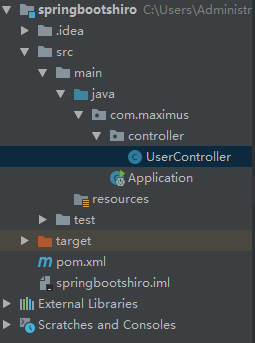Spring Boot快速入门(thymeleaf标签使用)
1.1 建立Maven项目,导入spring boot父工程(本人使用IDEA)


修改pom.xml:
<?xml version="1.0" encoding="UTF-8"?>
<project xmlns="http://maven.apache.org/POM/4.0.0"
xmlns:xsi="http://www.w3.org/2001/XMLSchema-instance"
xsi:schemaLocation="http://maven.apache.org/POM/4.0.0 http://maven.apache.org/xsd/maven-4.0.0.xsd">
<modelVersion>4.0.0</modelVersion>
<groupId>com.maximus</groupId>
<artifactId>springboot-shiro</artifactId>
<version>1.0-SNAPSHOT</version>
<!-- 继承Spring Boot的默认父工程 -->
<!-- Spring Boot 父工程 -->
<parent>
<groupId>org.springframework.boot</groupId>
<artifactId>spring-boot-starter-parent</artifactId>
<version>1.5.4.RELEASE</version>
</parent>
</project>
1.2 导入web支持
修改pom.xml:
<!-- 导入依赖 -->
<dependencies>
<!-- 导入web支持:SpringMVC开发支持,Servlet相关的程序 -->
<!-- web支持,SpringMVC, Servlet支持等 -->
<dependency>
<groupId>org.springframework.boot</groupId>
<artifactId>spring-boot-starter-web</artifactId>
</dependency>
</dependencies>
1.3 编写测试Controller类
package com.maximus;
import org.springframework.stereotype.Controller;
import org.springframework.web.bind.annotation.RequestMapping;
import org.springframework.web.bind.annotation.ResponseBody;
/**
* 测试Controller类
*/
@Controller
public class UserController {
/**
* 测试方法
*/
@RequestMapping("/hello")
@ResponseBody
public String hello(){
System.out.println("UserController.hello()");
return "ok";
}
}
1.4 编写SpringBoot启动类
package com.maximus.controller;
import org.springframework.stereotype.Controller;
import org.springframework.web.bind.annotation.RequestMapping;
import org.springframework.web.bind.annotation.ResponseBody;
/**
* 测试Controller类
*/
@Controller
public class UserController {
/**
* 测试方法
*/
@RequestMapping("/hello")
@ResponseBody
public String hello(){
System.out.println("UserController.hello()");
return "ok";
}
}
当前项目架构:

运行启动类,出现以下界面表示启动成功:

打开浏览器輸入:http://localhost:8080/hello 出现以下界面表示测试成功

1.5 导入thymeleaf页面模块
pom.xml 中引入thymeleaf依赖
<!-- 导入thymeleaf依赖 -->
<dependency>
<groupId>org.springframework.boot</groupId>
<artifactId>spring-boot-starter-thymeleaf</artifactId>
</dependency>
在Controller添加测试方法
/**
* 测试thymeleaf
*/
@RequestMapping("/testThymeleaf")
public String testThymeleaf(Model model){
//把数据存入model
model.addAttribute("name","MaximusRj");
//返回test.html
return "test";
}
建立test.html页面
在src/main/resource目录下创建templates目录,然后创建test.html页面
<!DOCTYPE html>
<html xmlns:th="http://www.w3.org/1999/xhtml">
<head>
<meta charset="UTF-8"/>
<title>测试Thymeleaf的使用</title>
</head>
<body>
<h3 th:text="${name}"></h3>
</body>
</html>
在thymeleaf3.0以前对页面标签语法要求比较严格,开始标签必须有对应的结束标签。
如果希望页面语法不严谨,但是也能够运行成功,可以把thymeleaf升级为3.0或以上版本。
升级thymeleaf3.0.2版本:
<!-- 修改参数 -->
<properties>
<!-- 修改JDK的编译版本为1.8 -->
<java.version>1.8</java.version>
<!-- 修改thymeleaf的版本 -->
<thymeleaf.version>3.0.2.RELEASE</thymeleaf.version>
<thymeleaf-layout-dialect.version>2.0.4</thymeleaf-layout-dialect.version>
</properties>
运行启动类,打开浏览器輸入:http://localhost:8080/testThymeleaf 出现以下界面表示测试成功:

本章节源码:git地址:https://gitee.com/maximusrj/springboot-shiro.git
**下一章节:Spring Boot与Shiro整合实现用户认证**